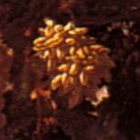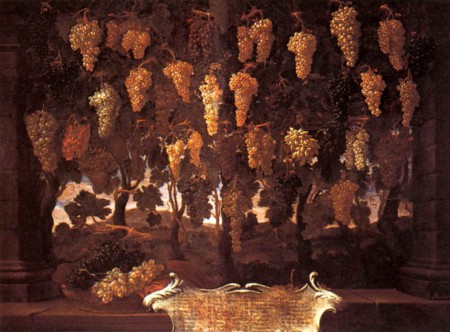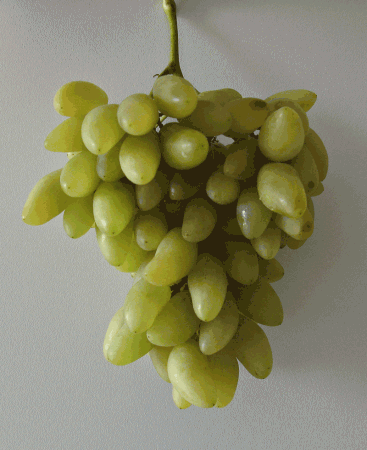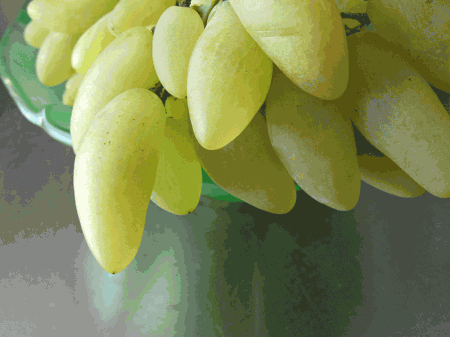- Everyday agriculture mysteries solved.
- Other animals self-medicate too.
- Dueling pigeonpea genome sequencers? Who knew. Well spotted, James.
- I’m thankful for turkeys.
- And for the crop wild relatives in ICARDA’s genebank too.
Nibbles: Taiwan seedbank, American agroforestry
- Taiwan should establish a national seed bank. It says here. But will it be a genebank?
- Agroforestry in the USA and in the ancient Maya lands.
Those elusive pizzutelli, again
With thanks to Giuseppe for pointing out another fruit painter, I went looking for Bartolomeo Bimbi’s depiction of our current favourite grape, and found a reasonable version. I reckon that’s it fourth from the right in the third row down.
 Unfortunately, on the version I found the names of the varieties, which I take to be somewhere within the escutcheon at the bottom of the painting, are illegible. Having looked at all the bunches hanging there, that’s the only one that does seem vaguely horn shaped. The original is in the Villa Medicea in Poggio a Caiano, about 15 km northwest of Florence, and if I’m ever in the area I’ll try and get a better look. Old paintings and manuscripts are clearly a good source of information for modern-day fans of diversity sleuthing, although I confess I rely on others more expert than me to do most of the legwork. A perfect example is Andrea Borracelli, whose website is full of this kind of information (and for which I am grateful).
Unfortunately, on the version I found the names of the varieties, which I take to be somewhere within the escutcheon at the bottom of the painting, are illegible. Having looked at all the bunches hanging there, that’s the only one that does seem vaguely horn shaped. The original is in the Villa Medicea in Poggio a Caiano, about 15 km northwest of Florence, and if I’m ever in the area I’ll try and get a better look. Old paintings and manuscripts are clearly a good source of information for modern-day fans of diversity sleuthing, although I confess I rely on others more expert than me to do most of the legwork. A perfect example is Andrea Borracelli, whose website is full of this kind of information (and for which I am grateful).
From him, we learn that Galletta Bianca belongs to the group ‘Pizzutello’ for the characteristic shape of the berries, and was found 1 in the area of Montepulciano, growing in family gardens. It is an old Tuscan variety … described in 1809 by Targioni Tozzetti as having “acini corniculatis flavescentibus” — horn-shaped, yellow berries. Galletta Bianca (there is also a black form), differs from the known Pizzutello white, 2 is listed in the Catalogue of Betti (1851) 3 and in the catalogue for the Public Exhibition of the Horticultural Society of Tuscany (1858). Low (1982) lists Uva Cornelia as a synonym for Galletta Bianca. Vine of medium vigour, with normal (?) productivity, limited to the provinces of Siena and Arezzo. It has an average percentage of fruit set, with the first fruiting shoot on the third or fourth bud, with two inflorescences per shoot, and has a normal tolerance to the most common parasitic diseases.
And I reckon that’s about all the sleuthing we’re going to do, unless, of course, something even more interesting turns up.
Just for comparison, here are a couple of my own pictures of pizzutello bought just up the road a little more than a month ago.
Bimbi, by the way, clearly had a great interest in diversity; he also painted a two-headed lamb for Grand Duke Cosimo III de’ Medici.
Tracing Arcadian wheat
One of those varieties is Arcadian, which was grown in New York State as recently as the 1920s; it had gone so thoroughly out of fashion that when officials from the U.S. Department of Agriculture sought it for their seed bank in 1991, they had to get it from Russia. (And even that, he says, may not be identical to the New York strain.)
Well of course I’ve needed much less encouragement than that provided by this snippet from a Smithsonian Magazine piece on artisanal wheats in the US to don the fireproof suit and venture into Genebank Database Hell. Especially with Eurisco launching a new website on the same day and all.
So here’s what I found out. The USDA National Small Grains Collection did indeed receive in Oct. 1991 the accession WIR 22038 from the N.I. Vavilov Research Institute of Plant Industry (VIR), being a sample of the wheat variety “Arcadian”, released in New York in 1895. It was given the number PI 565362 in 1993. There’s now a bunch of evaluation data on it in GRIN.
But where did VIR get it from? Well, Eurisco does have a record of a VIR100022038, 4 collected in 1928, country of origin the USA, but that’s about all. So was it collected by Vavilov himself? There’s nothing on the identity of the collector on VIR’s own online database. Vavilov visited the USA in 1921 and 1930, going to New York on the first occasion, but that seems too early compared to the VIR acquisition date of 1928. Maybe he sent a request for additional material to the contacts he had made? And with that I leave it to the Vavilov experts (or my next visit to St Petersburg) to continue following the trail…
More on Pizzutello
Our post of a couple of days ago on Ruoppolo’s grapes found its way to an actual grape expert, Anna Schneider of the Istituto di Virologia Vegetale in Italy. I’ve translated her comments below:
I did some research on Ruoppolo and saw that he worked in Naples, so it is indeed possible that the grapes he represented are Pizzutello white, which is actually still grown in Tivoli together with Pergolese and still arrive in the markets of Rome.
On the difference between the painting and the image of the Dedo de dama of Portugal, which is synonymous with Pizzutello, I am not worried: the color obviously depends on environmental conditions, and also the elongation of the berry may be: a) an exaggeration of the artist (who usually tended to exaggerate the more unusual characters, b) intra-varietal diversity (often mostly present in some varieties), c) growing conditions in the absence of “forcing”.
Other synonyms of the same grape variety, which was one of the most popular table varieties in the Mediterranean basin, because of the shape of the berry, to the particular form of the berry, are Cornichon blanc (France), Corazon de cabrito and Teta de vaca in Spain.
These synonyms are the “official” ones; unofficial ones number in the hundreds are hundreds (Galletta, Uva corno, Cornicchiola, Lady finger, etc…)
As a final note, I have a Pizzutello look-alike I recovered in old vineyards that seems a distinct genotype. In fact, it is possible that there is more than one variety with such a berry (and called the same ), although this Pizzutello (Cornichon, Dedo de dama, etc..) Is probably the most widely cultivated both today and in the past and among the oldest documented varieties (perhaps the dactyli grape of Pliny? though as you know such correspondences can never be definitely proven…)
To find out more I would need to do a more thorough search in the literature and among molecular profiles, but for that I would need a little more time…
Many thanks to Anna for taking the time to provide more information than I would have ever have been able to get out of the databases.


